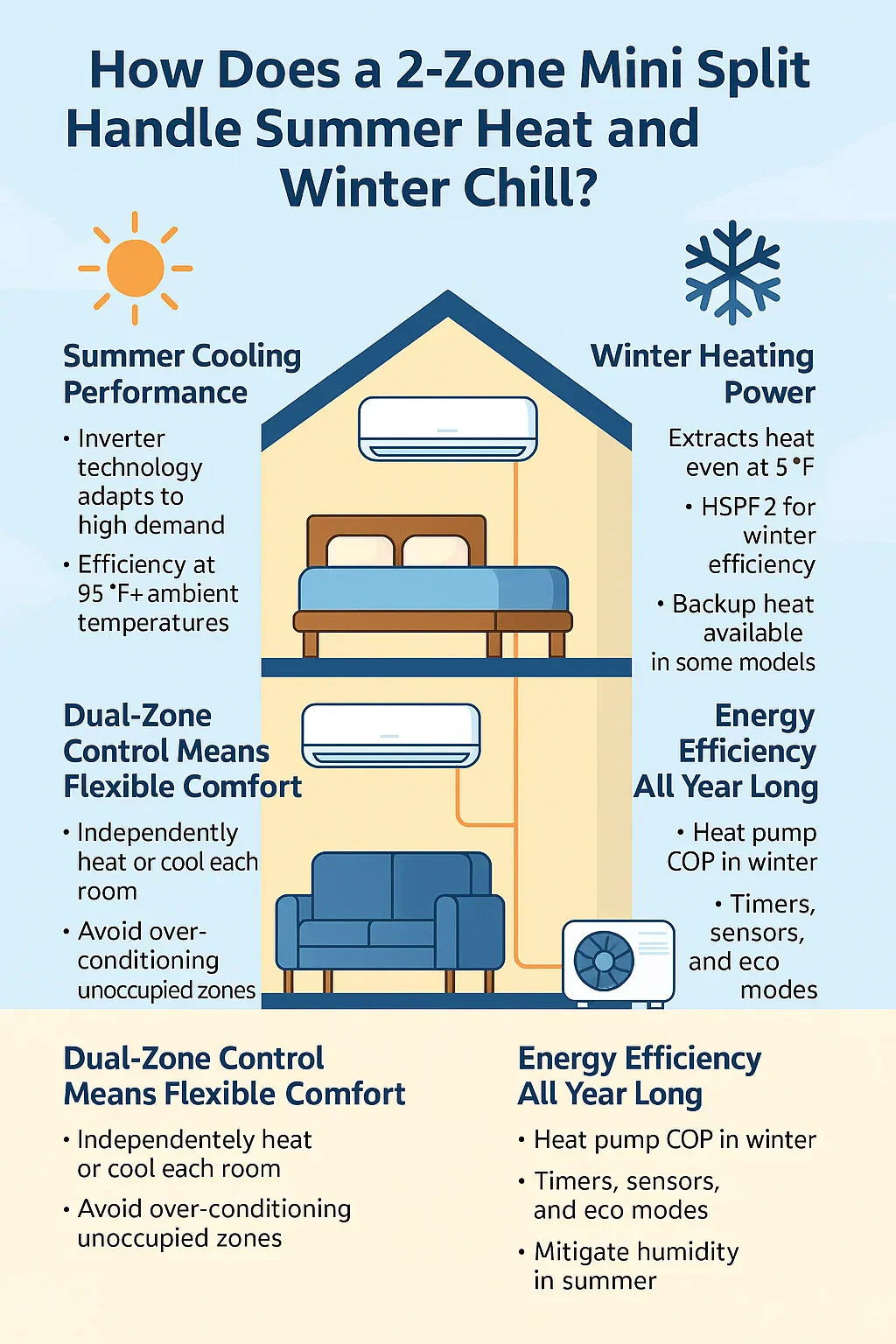When Jake set out to modernize his home’s heating and cooling, he wondered: Can a 2-zone mini split really replace my old central HVAC system year-round? The answer, for thousands of homeowners like Jake, is a confident yes. But only if you understand how these systems perform under seasonal extremes—and choose the right setup for your space.
This guide walks through how 2-zone systems handle everything from triple-digit heatwaves to subzero snowstorms, how to read their performance ratings, and how to plan your system for comfort all year long.
☀️ Beating the Summer Heat: Cooling Capacity Explained
Modern 2-zone mini split systems excel at cooling your home even on the hottest days. Here’s how:
✅ Inverter Compressor Technology
Inverter-driven compressors automatically adjust speed and output based on demand. This allows:
-
Fast ramp-up during heatwaves
-
Lower energy use during mild weather
-
No abrupt on-off cycles like traditional systems
✅ SEER2 Ratings for Efficiency
SEER2 (Seasonal Energy Efficiency Ratio 2) is the 2023+ standard for cooling efficiency. The higher the number, the more cooling output you get per watt of electricity used.
-
Entry-level 2-zone systems: ~16 SEER2
-
High-performance systems: 21+ SEER2
✅ Zoned Control = Smarter Cooling
With a 2-zone system, you’re only cooling the rooms you actually use. For example:
-
Jake keeps the bedroom at 70°F overnight
-
The home office stays warmer until morning
That targeted control saves energy and boosts comfort.
✅ Real-World Scenario: Jake’s 1,400 Sq Ft Home
-
9k BTU head for bedroom
-
12k or 18k BTU head for open-concept living area
-
Condenser outside with 21 SEER2 rating
-
Keeps both spaces cool even during 100°F heatwaves in Texas
❄️ Braving the Winter Chill: Can It Really Heat?
Yes—today’s mini split heat pumps can heat your home, even in below-freezing weather. But performance depends on the system.
✅ Heat Pump Basics
Rather than burning fuel, mini splits work by extracting heat from the outdoor air—even when it’s cold—and moving it inside.
✅ HSPF2 Ratings for Heating Efficiency
HSPF2 (Heating Seasonal Performance Factor 2) is the updated heating counterpart to SEER2.
-
Budget systems: 7.5–8.2 HSPF2
-
Cold climate systems: 9.5–11.0 HSPF2
🧪 Compare models using Energy Star’s product finder
✅ Cold Climate Heat Pumps (CCHPs)
For homes in northern zones, choose a unit labeled as a Cold Climate Heat Pump:
-
Operates down to -5°F or colder
-
Maintains 80%+ capacity at low temps
-
Often includes base-pan heaters to prevent ice buildup
📌 Example: Mitsubishi Hyper-Heat system performance
🧠 Dual-Zone Intelligence: Smart Room-by-Room Control
Jake lives in a house where the home office gets morning sun and heats up early, but the basement bedroom stays chilly. With two zones, he can:
-
Set the office to 68°F from 9am–5pm
-
Keep the bedroom at 65°F until bedtime
-
Adjust via app or smart thermostat from his phone
Top brands offer:
-
Voice control (Alexa/Google)
-
Motion sensors
-
Weekly scheduling
-
App-based remote access
🔗 See how LG ThinQ integrates with smart home devices
🏆 Brand & Model Comparisons: Year-Round Stars
✅ Top Systems for Extreme Heat + Cold:
-
MRCOOL DIY Gen 5: Up to 22 SEER2, down to -13°F heat
-
Daikin Aurora Series: Excellent low-temp heating
-
Mitsubishi Hyper-Heat: Designed for -5°F and below
-
LG Multi F Max: High efficiency dual-zone performer
📌 See MRCOOL’s performance chart here
📏 Sizing for Both Summer and Winter
Choosing the right BTU levels is critical for all-season comfort. Jake’s 1,400 sq ft home needs:
-
9k BTU in bedroom (up to 400 sq ft)
-
12k or 18k BTU in living area (400–700+ sq ft)
-
Proper line set length, elevation, and insulation
Oversizing can create problems in both seasons:
-
Summer: Short cycles, poor humidity control
-
Winter: Frequent defrost cycles, inefficient operation
💡 Energy Efficiency Tips Year-Round
Jake also discovered these smart ways to boost performance:
-
Use ceiling fans with mini splits to circulate warm air in winter
-
Keep filters clean every 2–4 weeks
-
Shade the outdoor condenser from direct sun
-
Close doors in unoccupied zones
-
Program temperature setbacks at night or when away
🔧 Maintenance for Seasonal Performance
Seasonal maintenance ensures your mini split handles the extremes:
-
Spring: Clean filters and outdoor coil before AC season
-
Summer: Monitor condensate drain for clogs
-
Fall: Check defrost mode before heating starts
-
Winter: Clear snow and ice from condenser unit
📌 Follow this EPA HVAC maintenance checklist
✅ Jake’s All-Season Takeaway
“I used to think I needed a furnace and a big AC to stay comfortable all year. But my 2-zone mini split? It cools my office in July and heats my bedroom in January—without draining my wallet.”
Whether you’re living in Florida or Minnesota, a well-planned 2-zone mini split system can deliver efficient comfort in any season—if you size it right and choose the right model for your local climate.







